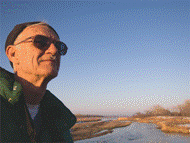Papers in the Biological Sciences

Paul Johnsgard Collection
Document Type
Article
Date of this Version
4-2011
Abstract
Much less apparent and well known than the annual crane migration is Nebraska’s role in the spring and fall migrations of shorebirds such as sandpipers, plovers, curlews and godwits. These migrations are inconspicuous, in part because of the fact that most long-distance shorebird flights occur at night. Shorebirds also never migrate in the enormous flocks that are so typical of geese and cranes, and their flights are usually unaccompanied by loud calls. Yet, they are massive if nearly invisible migrations, involving over 30 species and an estimated 200,000–300,000 birds. Many of the species travel from South American wintering grounds, and about half of them are bound for arctic tundra breeding grounds of Canada and Alaska. While resting and feeding between flights, the birds scatter across Nebraska’s smaller and shallower wetlands, from the undulating loess plains of Rainwater Basin between the Platte and Republican rivers, across the wet meadows of the Platte Valley, to the thousands of remote Sand Hills wetlands nestled between the Platte and Niobrara rivers.
Nebraska’s wetlands are a small but important part of an intercontinental series of important stepping- stones used by shorebirds on their migrations. Some locations are especially valuable for certain species but may be little used by others. For example, the otherwise undistinguished agricultural fields and wetlands centered in Seward and Fillmore counties are probably the buff-breasted sandpiper’s single most important spring stopover area between its Argentine wintering sites and its high-arctic nesting grounds. Not far to the south, the shallow marshes of Cheyenne Bottoms Wildlife Area in central Kansas supports nearly half of North America’s total shorebird population, including more than 90 percent of the white-rumped, Baird’s and stilt sandpipers, long-billed dowitchers and Wilson’s phalaropes surveyed during spring in central and eastern North America. To the north the glaciated potholes and sloughs of the Dakotas and southern Canada provide the major stopping points on the spring flights of many northern prairie or arctic-nesting species.


Comments
Published in Prairie Fire 5:4 (April 2011). Copyright ©2011 Prairie Fire Enterprises LLC.